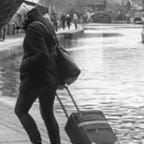God’s Lagos
Caroline Knowles & David Garbin
The entrance to the Mountains of Fire and Miracles (MFM) revivalist church HQ in the Onike neighbourhood of Lagos is behind high spiked walls and gates guarded by CCTV cameras. Inside, its vast auditorium is divided into sections so that congregants can seek redress for specific problems and guidance on their aspirations. MFM has taken over much of the neighbourhood it describes dismissively as ‘crime ridden’. Branded in yellow and purple like the church, the ‘Grace Hall’ assembly rooms sit opposite, with the bookshop, music school and playground also nearby. Like MFM’s school and university, all of these buildings are now entrenched in the fabric of the city. MFM’s investments, valuable inner-city land and congregants’ tithes and offerings enrich it. The colonisation of space and souls is gathering pace in this fast-growing sub-Saharan city, which has an estimated population of 24 million and rising.
At the edge of a city that just keeps extending through informal settlements, without essential services like water, power, sewage, and solid waste disposal, the MFM prayer camp holds half a million worshippers, with spill over space for a quarter of a million more. Described as the ‘Largest Church auditorium on planet earth’, with branches throughout Nigeria and worldwide including in London, MFM specialises in ‘deliverance’ and ‘spiritual warfare’. Chidozie, a driver in his thirties who cannot afford to marry or have a family and is struggling to make his way in the city, says this is vital. He suggests that MFM stands in for non-existent social welfare: the church helped him with his rent when he couldn’t pay it; it rescues street children and sends them to school; and has turned sex-workers into church choristers. Most of all, Chidozie says, the prayers, which he describes as ‘violent’, by which he means they involve a lot of body movement and head shaking, provide him with ‘grace’. Grace makes him feel empowered, able to ‘break out of the chains’ which tie him to a seemingly hopeless situation, with little prospect of improvement. MFM provides hope in a city that has all but abandoned its people to fend for themselves. Where cities are broken, and people must look out for themselves, God, and Pentecostal churches like MFM, help people to navigate the overwhelming precarity of everyday life.
The religious urbanisation in Africa project (RUA),[i] headed by David Garbin and his colleagues at the Universities of Lagos, York, and Toronto, and funded by the British Academy Global Challenges Research Fund Cities and Infrastructure Programme, has been exploring the influence of religious actors and organisations on cities. Researchers working on this project suggest that despite the transformation of sub-Saharan cities by revivalist religions like MFM, cities are usually understood as secular matters, stressing planning, infrastructure provision and so on. But what happens, the researchers ask, when churches like MFM successfully divert city planning to support their own expansion and land grabbing? What happens when churches provide water, electricity, health, and education for congregants while displacing others from the land and what few resources they have? Churches, David Garbin and his team argue, have stepped into a void left by a shrinking and failing state, hobbled by the 1986 World Bank and IMF economic reforms. This has created new kinds of ‘born again’ citizens and religious enclaves in the city, which are dominated by religious values, practices, and buildings. David Garbin and his team tentatively suggest that these moves result in something akin to religious gentrification. This refers to rising land and rent values, and the displacement of, or interference in, the lives of existing residents and traders. In all, religious gentrification takes over neighbourhoods in the interests of the church.[ii]
RUA researchers show how Pentecostal churches are profoundly changing the city of Lagos and the everyday lives of those who live there. Religious leaders, members of religious organisations but also local stakeholders such as urban planners agree that religious urbanisation provides much-needed urban resources, infrastructures, and welfare provisions in the context of state disengagement. At the same time, it reproduces inequalities. Religious schools, universities and hospitals charge disproportionally more than most of their public secular counterparts. Exclusive religious enclaves fragment cities by taking advantage of gaps in urban planning or municipal governance, as the research in Onike shows.
The RUA project concludes that religious urbanisation — which in Lagos is also driven by Muslim organisations and non-Pentecostal Christian churches — simultaneously makes the city a better and a worse place for Chidozie to live.
[i] Religious Urbanisation and Infrastructural Lives in African Megacities (RUA project) investigates megachurches like MFM in Sub-Saharan Africa’s largest and fastest growing cities, Lagos and Kinshasa, DRC. Researchers include David Garbin (University of Kent), Taibat Lawanson (University of Lagos), Simon Coleman (University of Toronto) and Gareth Millington (University of York). See https://rua-project.ac.uk
[ii] For more detail see, Taibat Lawanson and Gareth Millington’s chapter in David Garbin, Simon Coleman, and Gareth Millington (eds) 2022, Ideologies and Infrastructures of Religious Urbanization in Africa: Remaking the City, published by Bloomsbury, https://www.bloomsbury.com/uk/ideologies-and-infrastructures-of-religious-urbanization-in-africa-9781350152120/
